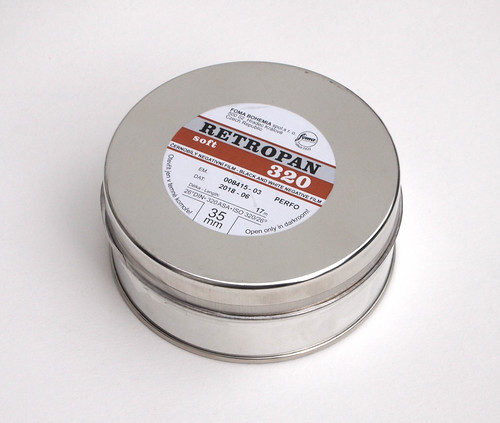 |
| Foma Retropan 320 Soft 35mm bulk film |
In May this year, Foma announced a new film,
Retropan 320 Soft. As the past few years have seen the market for film contract, and products discontinued, any news of new films provokes interest - and sometimes a little scepticism - from film photographers online. Foma has both the well-established Fomapan 400 and 100, and recently re-introduced their 200 speed film to their product lines, a new film at a speed fractions of a stop between the two needs to have distinctly different characteristics to be a worthwhile addition. Foma
states that Retropan 320 soft is:
is a panchromatically sensitized special negative black and white film with fine grain, good resolution and contour sharpness. The film is characterized by a wide range of half tones and soft light which makes it suitable for photography and subsequent contact printing or “retro” style enlarging of negatives (photographs of still lives, architecture, experiments, landscapes, portraits, etc.)
The choice of name for this new film provides an indication of these qualities, and it could be said that the speed itself, 320 ISO, has something 'retro' about it, there being only one other black and white film rated 320, Tri-X sheet film. Retropan 320 Soft is currently only available in bulk rolls of 35mm and large format sheet films. For this post about the film, I have only tested the emulsion in 35mm, but results for sheet film can no doubt be extrapolated from these. I bought a bulk roll from
Process Supplies, the only distributor in the UK so far.
As an entirely new film, there is as yet little data for developers and times. At the time of writing, Retropan 320 is not listed on the Massive Dev Chart; the data sheet from Foma gives times and dilutions for just four developers and their dedicated one (these are: Foma's new Retro Special Developer;
Ilford Microphen;
Kodak HC 110;
Spur NHC; and Rollei Supergrain). I don't use any of the listed developers, and although best results may be achieved in the manufacturer's dedicated developer, it may not be practical to buy specialist developers tailored to every film. Instead, I chose both of the two developers that I've used over a number of years: Rodinal (in this case, R09 One Shot) and Ilfotec LC29.
For my first test roll I had intended to process the film by using one hour
stand development in Ilfotec LC29 at 1+100; instead due to a mix up of tanks (the other tank had Kodak Plus-X), I developed this in Ilfotec LC29 diluted 1+29 for 9 minutes at 20ºC. It was immediately evident when pulling the film out of the wash that the negatives were of low contrast and good latitude; there is a grey base to the film, and it does not have any edge markings in 35mm, which can be useful for gauging development. However, the time and dilution used appeared relatively successful despite being entirely serendipitous. The first test roll was shot on an overcast morning, and the six-stop difference in exposures made for the latitude test appeared as a fairly gentle gradation across the frames. When scanning the negatives of this first test, these appeared to show a slightly usual tonal response: however, the grass under the trees was very yellow and reflective of the diffuse lighting conditions. I shot (in sunny conditions) and developed a second latitude test as I had initially intended, using stand development with Ilfotec LC29 diluted 1+100 (this went over the hour mark by a quarter, but with stand development and a film with good latitude, there would be naturally a wide margin in timings).
For a third test roll, I used stand development with R09 One Shot at 1+100. Although direct comparisons suffer the vagaries of each stage between subject and resulting image - metering, camera equipment, development and scanning - this roll appears to show fuller negatives. The first two rolls developed in Ilfotec LC29 looked as though rating the film at box speed risked a lack of shadow detail, especially in high contrast subjects. This is in part an issue of metering, but the negatives in R09 appeared to better achieve the stated box speed.
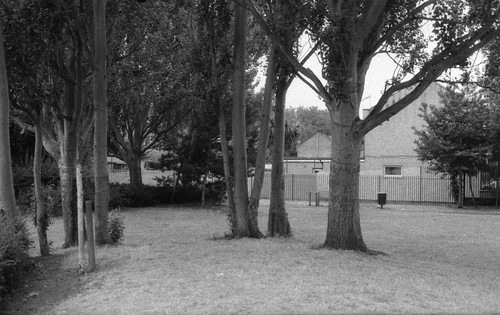 |
| Retropan 320 at box speed, developed in Ilfotec LC29 1+29, 9m at 20ºC |
 |
| Retropan 320 at box speed, stand developed in Ilfotec LC29 1+100 for 1 hour 15 minutes |
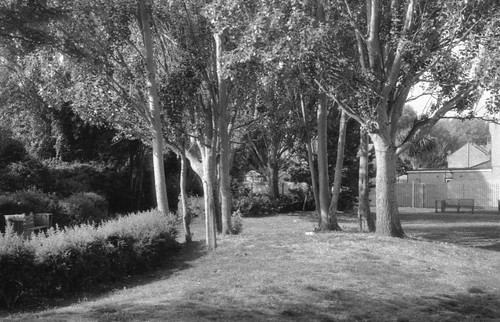 |
| Retropan 320 at box speed, stand developed in R09 One Shot 1+100 for one hour |
Foma's data sheet lists Retropan 320 Soft as having qualities of "fine grain, good resolution and contour sharpness". The first quality, fine grain, may be achievable with the dedicated developer. In the tests that I made, the grain appeared not untypical of a 400 ISO film, not what I would describe as 'fine grain'; there does appear a slight difference between the results developed in Ilfotec LC29 with normal agitation and stand development: the appearance of the grain is just perceptibly tighter when stand developed in the two images compared below.
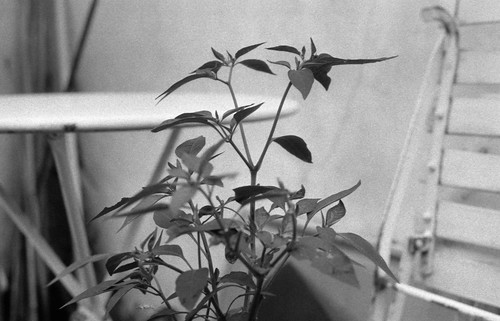 |
| Retropan 320 at box speed, stand developed in Ilfotec LC29 for one hour |
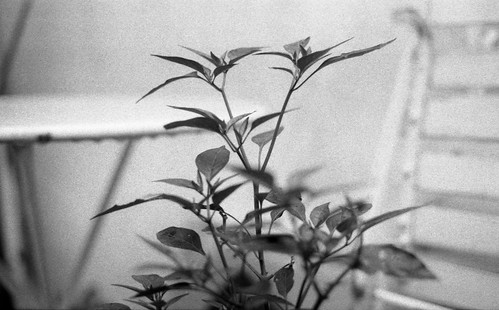 |
| Retropan 320 at box speed, developed in Ilfotec LC29, 1+29, 9m at 20ºC |
Retropan's "good resolution and contour sharpness" are more evident. There must be a relationship between fineness of grain, sharpness and resolution, although this is not necessarily a straightforwardly linear one: a film can be 'grainy' and still possess good resolution, and the converse may be true. The image below of the chain link and wooden fences does show these qualities, as does this photograph with a
spider's web showing up in this shot, and the
lettering in this photograph.
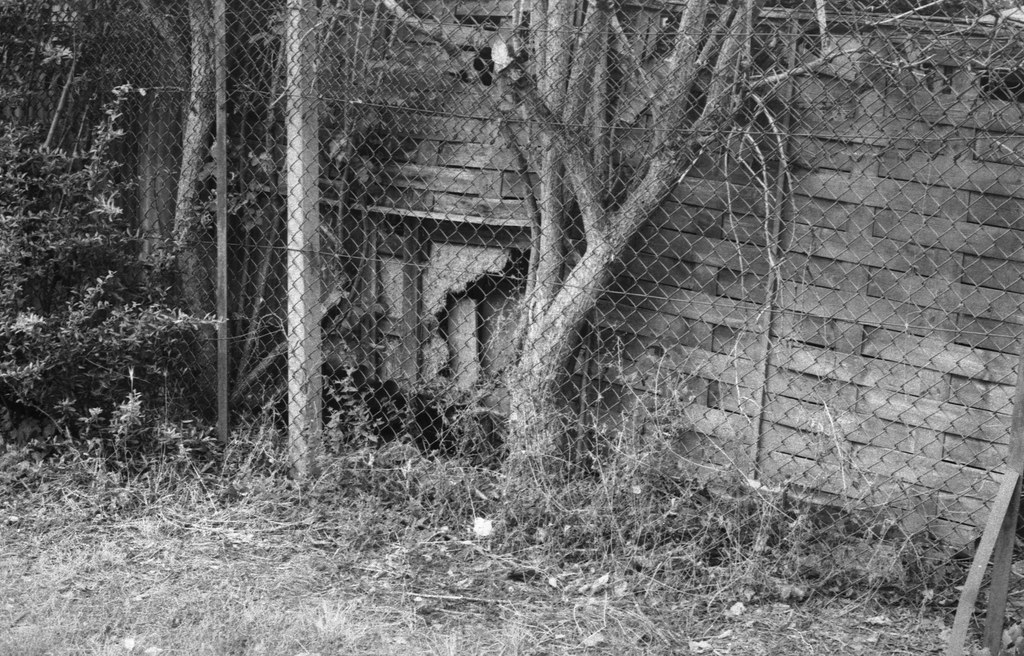 |
| Retropan 320 at box speed, stand developed in R09 One Shot, 1+100 for one hour |
The "soft light" described in the data sheet appears to be related to halation, and possibly irradiation. This may be due to the film having little or no anti-halation layer. In the tests I made, halation was more prominent when over-exposed, as one would expect, but as the film's good latitude means that it copes well with over exposure, so this effect could be deliberate by design (this can, incidentally, produce a look reminiscent of infrared film when these highlights are located on foliage). With regards to this effect, the data sheet states:
Base
The following bases are used for manufacturing the particular sorts of the film:
- 35 mm film - a gray or gray-blue cellulose triacetate base 0.125 mm thick,
- sheet film - a clear polyester base 0.175 mm thick furnished with an antihalo
colour backing which will decolourize during processing.
This suggests that in 35mm the film does not have a specific anti-halation backing, but the "gray or gray-blue" base
may be tinted so as to reduce halation, although the
effect of halation can clearly be seen in some of my results; this may also be light scatter due to irradiation, a separate but related effect.
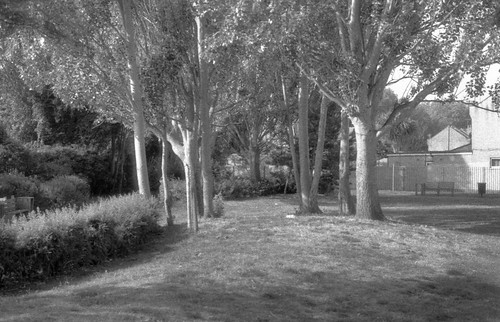 |
| Retropan 320, two stops overexposed, stand developed in R09 One Shot 1+100 for one hour |
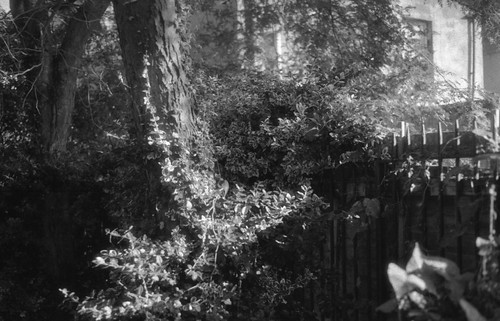 |
| Retropan 320 at box speed, stand developed in Ilfotec LC29 1+100 for one hour |
Additionally to overexposure as a general approach, specifically, subjects with bright local luminance - light areas against a larger dark background - emphasise these effects. This is in part due to metering: all the above tests were shot with an Olympus OM10, relying on its centre-weighted metering. The relationship of subject metering and exposure to development could be better correlated when shooting sheet film of course. These effects would also be less obvious with large format.
Foma's data sheet states that Retropan 320 Soft's "wide exposure latitude provides very
good results also when overexposed by min. 1 EV (ISO 160/23°) and
underexposed by 2 EV (1250/32°)." It provides times for rating the film at 640, but not 1250 (interestingly, all developing times on the data sheet are given as a range and not absolutes: these are all either one or two minutes). Given the results from the latitude tests that I shot, there seemed little point in specifically finding and adjusted developing time for rating the film at 160, but I did want to try push processing. I shot a roll of Retropan 320 rated at 640 with the
Voigtländer Vito IIa, developed in Ilfotec LC29 1+19 for 16 minutes at 18ºC. This guess at a developing time was based on the results from my first film, with less dilution, and what felt like a much increased time.
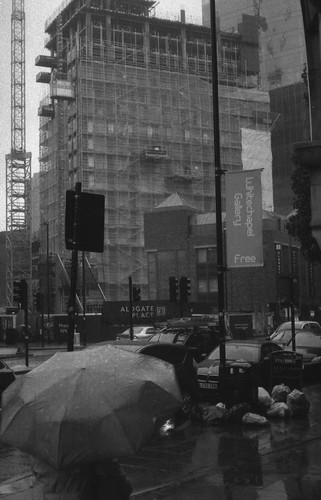 |
| Retropan 320 at 640, developed in Ilfotec LC29, 1+19, 16m at 18ºC |
For a two stops push, rating the film at 1250 ISO, I developed it in Ilfotec LC29 1+19 for 20 minutes at 19.5ºC. As is generally the case with push processing, the results in good, even lighting were better than the few that I shot at night (as underexposure and overdevelopment increases contrast, and night shots tend to be high contrast, with localised point sources of illumination and deep shadow areas). For a further test of push processing, I might chose less dilution, 1+9, with similar times. Despite local halation, the highlight areas appear resistant to blocking. The characteristic curves on the data sheet are cropped to the very start of the shoulder area: from the latitude tests, I have a suspicion that the film demonstrates a gentle rollover at the shoulder. The curves also show an unusual 'bent leg' to the straight line section, at least with the dedicated developer.
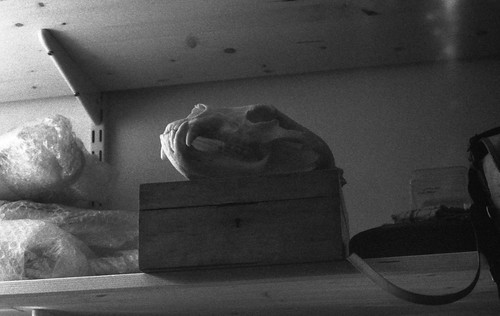 |
| Retropan 320 at 1250, developed in Ilfotec LC29, 1+19. 20m at 19.5ºC |
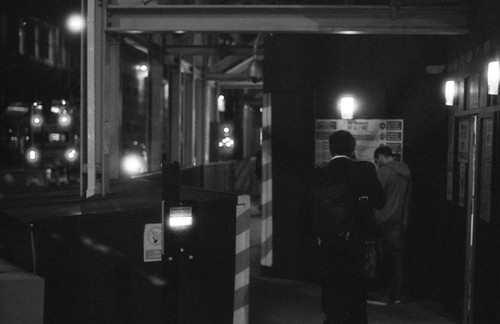 |
| Retropan 320 at 1250, developed in Ilfotec LC29, 1+19, 20m at 19.5ºC |
All the tests I've made so far
do show Retropan 320 to have quite distinct qualities, and so providing perhaps some kind of niche for it as a product, although these are an unusual combination; I've found it to be a bit of a curate's egg. With limited availability and limited information from the manufacturers, this does provoke some speculation about the intentions for the new film. Presumably what is currently available represents a limited batch of emulsion made to test market viability, but Foma's production of a dedicated developer for it demonstrates a willingness to support Retropan 320 at least for the immediate future; with sufficient demand, availability in 35mm cassettes and medium format rollfilm would confirm this.
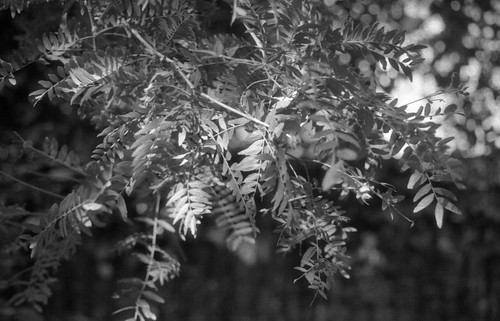 |
| Retropan 320 at box speed, stand developed in Ilfotec LC29 1+100 for 75 minutes |
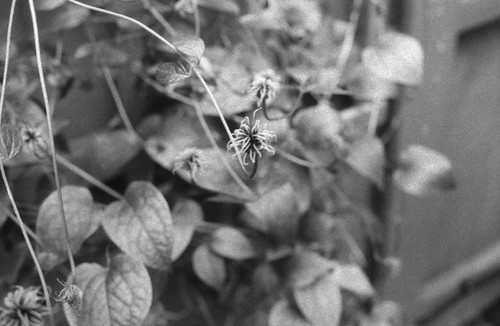 |
| Retropan 320 at box speed, stand developed in R09 One Shot, 1+100 for one hour |
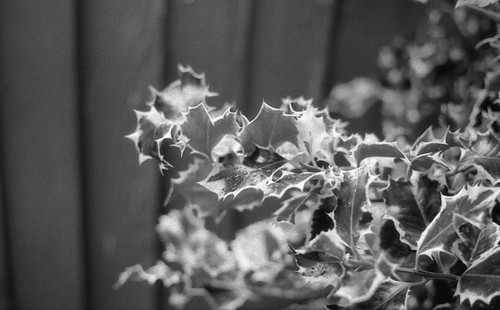 |
| Retropan 320 at box speed, developed in Ilfotec LC29, 1+29, 9m at 20ºC |
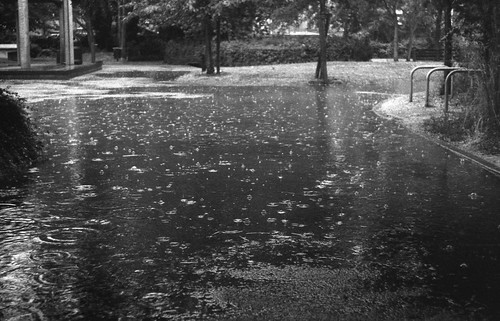 |
| Retropan 320 at 640, developed in Ilfotec LC29, 1+19, 16m at 18ºC |
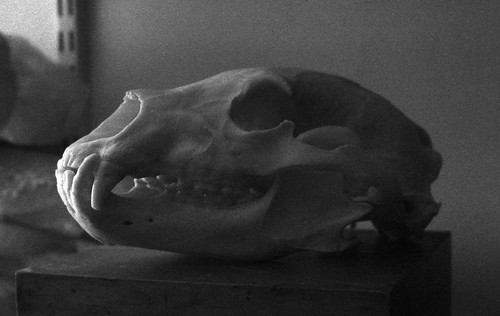 |
| Retropan 320 at 1250, developed in Ilfotec LC29, 1+19, 20m at 19.5ºC |

















Very interesting article, thank you very much for taking the time to provide all the info. I'm still very curious about the grain that can be gotten from this film, I wonder how it will behave pushed very far.
ReplyDeleteThanks. Retropan 320 never quite behaved as I expected it to, so it might be worth seeing what results a three-stop push give; the limited manufacturer's recommendations made it difficult to find good starting points for the tests.
DeleteI'm interested to know if you think this film is anything like Kodak plus-x?
ReplyDeleteNo - I don't think it shares many characteristics with Plus-X - it's faster, lower contrast, and has more pronounced grain. Closest current film to Plus-X is probably Ilford FP4 Plus.
Delete